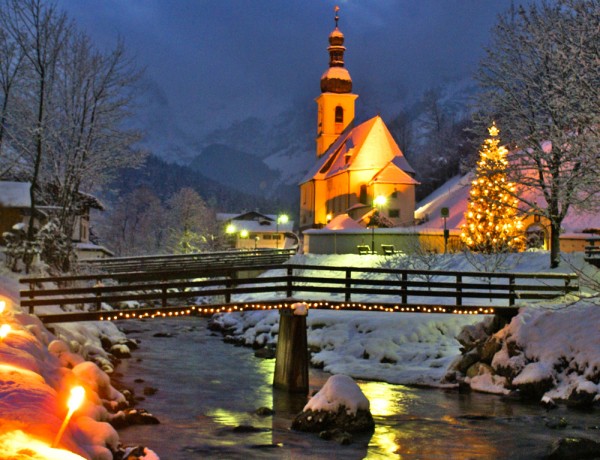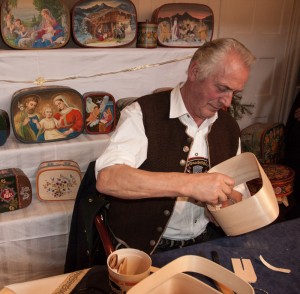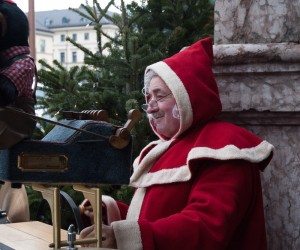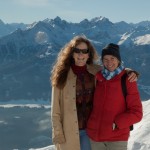For a heart-warming Christmas, head to Bavaria and Tyrol in the frosty Alps.
By Donna Peck

Revelers indulge in every Yuletide tradition across the Alps. Munich and Innsbruck are smothered in Christmas splendor. Frosted lights glow in windows; light strands cascade from arches, beach-ball-sized ornaments swing from sidewalk trees.
When Christmas markets open, trumpets sound and the monthlong festivities begin.
Munich and the Bavarian Alps
As offices close, Müncheners follow the smell of sizzling sausage to the town square, the city’s largest Christmas market. Because food is prepared outdoors, the market is redolent of bratwurst (long, thin veal sausage), homemade spaetzle and cabbage, and fried potato pancakes with cranberry sauce.

The smell of glühwein in steaming cauldrons entices as well. Vats of this fragrant red wine, spiced with cinnamon sticks, vanilla pods, cloves, sugar and citrus peel are consumed throughout the season.
Grilled sausage and glühwein in hand, co-workers and neighbors chat between sips and bites. A hush falls when carolers sing from the Town Hall balcony, “Hark! The Herald Angels Sing.” Hours later, the glockenspiel bells in the tower play a good night melody, and Müncheners drift toward home or the Ratskeller.
Unchanged for generations, the Ratskeller beer hall is a treasure of Bavarian workmanship with carved wooden booth, hand-painted murals and arched ceilings. Wiener schnitzel, the speciality of the house arrives moist and tender in a light crust, perhaps the best veal you’ve ever had.

Smaller Christmas markets are scattered through the city, in parks and public squares. Wittelsbacher Platz is transformed into into Sherwood Forest with a village of miniature wooden cottages.
Inside, artists blow glass, carve wood and fashion gold buckles. Fascinating to watch. An artist skilled in medieval weaponry embellishes a deerskin sheath with beads and feathers. He stops to sell a handmade bow, made with exquisite care. Manufactured goods are forbidden as is electricity. A not-so-merry food vendor can’t keep the fire in his barrel lit. True-to-life, he curses.

At Viktualienmarkt’s Backstube Rischart bakery, the pastry chef pulls a tray of gingerbread cookies from the oven and offers samples. Delicious dipped in dark, rich coffee. The bakery dates back to 1883 when icing-painted cookies first caught on. Now gingerbread ornaments adorn the family Christmas tree.
Outside the Royal Residence, a street vendor in a red cloak sets up a music cart and plays Christmas carols on a concealed CD player. He accompanies the holiday favorites, rather inexpertly, on a bugle, snare drum and cymbals.

A mechanical monkey doffs his hat when coins drop into the collection tin. Inside the courtyard, the Christmas market resounds with squeals and laughter.
A moose automaton sings the German version of “Jingle Bells.” Parents load children into an ornate sleigh with automaton reindeers.
Berchtesgaden
Bavarian villages observe St. Nicholas Eve early in December. All Berchtesgaden turns out to witness the arrival of St. Nicholas. At sunset, the bishop appears with an angel and wild Krampus, men dressed in fur garments belted with cowbells and brandishing switches.

The Krampus charge the crowd, lashing people’s legs with birch switches. One fleeing girl gets caught and returns laughing, her face smudged with soot.
After a few hours of mayhem, the wild men set aside their masks and cowbells and retire to Gasthaus Goldener Baer for grilled trout and beer.

The grilled trout comes from swift-flowing rivers in the Alps. Electric sightseeing boats operate in winter on green, trout-rich Lake Königssee in Berchesgaden National Park.
The captain cuts the motor beside a sheer rock wall. Taking up his bugle, he goes outside and trumpets a slow tune. The mountain echoes the song several times, ever more faintly.
Innsbruck and the Tyrolean Alps
Innsbruck’s normally festive mood is heightened during Christmas. The Tyrol capital once entertained Emperor Maximilian I, who if sitting on his gold balcony today would see not a tournament but a thronged Christmas market.

The village of Götzens above Innsbruck hosts sleigh rides. The Götzens tram ascends a plateau to miles of trails groomed for winter outings.
The sleighs are handsome vehicles with high leather seats, long runners, and polished harnesses. The drivers yodel so prepare for an ear-splitting virtuoso performance. The alpine setting feels surreal. Sunlight flashes on the mountain ice and the mind sees silver organ pipes.
Igls

The village of Igls—bright in the starlight—hosts nocturnal walks. The guide hands out kerosene lanterns, crosses a bridge and follows a stream to a steep path then up to a hilltop. The 7,639 foot-high peak of Patscherkofel, outlined and crowned with stars, is clearly the village guardian.
The walk ends amid the warmth and merriment of Heiligwasser restaurant over bowls of beef stew and sweet pancakes, kaiserschmarren, made with raisins and plum sauce.
The build up to Christmas Day is palpable. On Christmas Eve, silence falls over the crowd at the illuminated Christmas market where all of Innsbruck has gathered to hear the bell-like voices of young choristers sing “O Tannenbaum.” The melody conveys the emotion of the short-lived season and a lingering sensation that all is well with the world.

We joined in the shopping, singing, drinking, and feasting—and skiing—across the Alps.
Photography by Donna Peck. Krampus photo by Sony Stark.






Leave a Reply